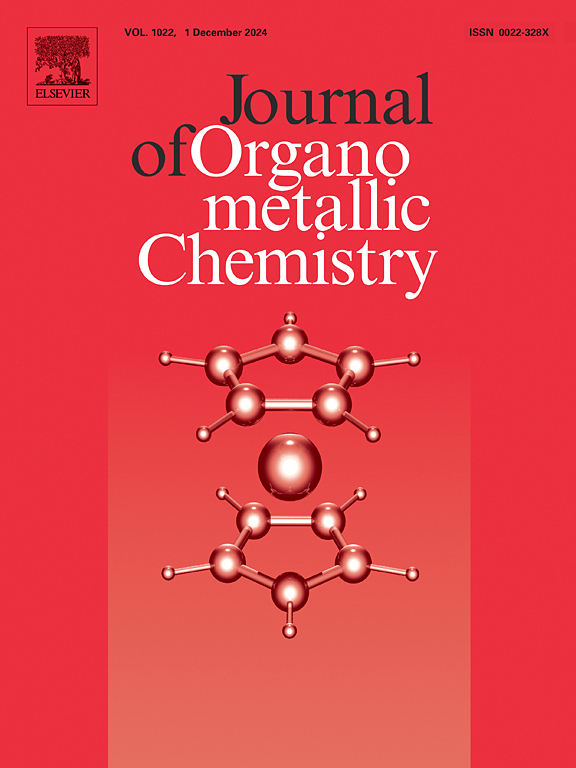Exploration of transition metal-hydride compounds: Molecular structure, electronic properties, nonlinear optical characteristics, and reactivity of Cp-based binuclear ruthenium complexes
IF 2.1
3区 化学
Q3 CHEMISTRY, INORGANIC & NUCLEAR
引用次数: 0
Abstract
This paper reports a systematic DFT investigation of four Cp-bridged binuclear ruthenium complexes; Cp‡Ru(μ-H)4RuCp‡ (A1), CpRu(μ-H)2(μ-η2-C6H4O2)RuCp (A2), CpRu(μ-B(N,N-dimethylphenylenediamine))(μ-H)3RuCp (A3), and Cp‡Ru(μ-CCH3)2RuCp‡ (A4), employing B3LYP/Lanl2dz-6–31G(d,p), B3LYP/def2-TZVP, and PBE0/def2-TZVP levels of theory. Optimized geometries showed excellent agreement with experimental data: Ru–Ru bond lengths deviated within ±0.10 Å; Ru–Cp bonds were overestimated by 0.03–0.11 Å; and bond angles, such as Ru–(μ-H)–Ru, were reproduced within 3°, with PBE0/def2-TZVP showing the smallest deviation (0.1° for A4). Frontier molecular orbital analysis revealed A1 had the largest HOMO/LUMO gap, indicating high stability, while A2 exhibited the smallest, suggesting enhanced reactivity. Global reactivity results highlighted A3 with the lowest ionization potential, and A2 with the highest electron affinity, electronegativity, electrophilicity, softness, and chemical reactivity. MESP maps identified nucleophilic hydrides in A1 and A3, and nucleophilic zones on benzoquinone oxygens in A2. NBO analysis revealed strong metal-ligand delocalization with 4d8 Ru orbital occupations. A2 displayed orbital asymmetry and minor 2 s hydrogen contribution, indicating potential agostic bonding. A1 and A4 showed localized Ru–Ru and Ru–H bonding, while A2 and A3 exhibited more symmetric charge distributions. TD-DFT in acetonitrile showed that A1 excels as a high-energy light-harvesting candidate due to its strong MLCT and ILCT transitions, while A2 is ideal for red-shifted absorption applications. A3 and A4, with mixed charge transfer contributions, offer potential for multifunctional roles in optical devices and catalysis. NLO analysis identified A3 as most promising, with A2 showing highest dipole moment and A4 greatest polarizability. APT charges confirmed increasing negative Ru centers across methods, strong σ-donation from μ-CCH3 in A4, π-backbonding in A2–A3, and a highly electron-deficient boron in A3 (+0.971), underscoring structure–property correlations relevant for optical and electronic design.
过渡金属氢化物化合物的探索:cp基双核钌配合物的分子结构、电子性质、非线性光学特性和反应性
本文报道了四种cp桥联双核钌配合物的系统DFT研究;Cp‡Ru(μ- h)4RuCp‡(A1)、CpRu(μ- h)2(μ-η - c6h4o2)RuCp (A2)、CpRu(μ- b (N,N-二甲基苯二胺))(μ- h)3RuCp (A3)和Cp‡Ru(μ- cch3)2RuCp‡(A4),采用B3LYP/ Lanl2dz-6-31G (d,p)、B3LYP/def2-TZVP和PBE0/def2-TZVP理论水平。优化后的几何形状与实验数据非常吻合:Ru-Ru键长偏差在±0.10 Å;Ru-Cp键被高估了0.03-0.11 Å;键角(如Ru - (μ-H) - Ru)在3°范围内,PBE0/def2-TZVP的偏差最小(A4为0.1°)。前沿分子轨道分析显示,A1的HOMO/LUMO间隙最大,稳定性高,而A2的最小,反应性增强。整体反应性结果显示,A3具有最低的电离电位,而A2具有最高的电子亲和性、电负性、亲电性、柔软性和化学反应性。MESP图谱在A1和A3中发现了亲核氢化物,在A2中发现了苯醌氧的亲核区。NBO分析显示4d8 Ru轨道占位导致金属配体离域。A2表现出轨道不对称和少量的2s氢贡献,表明潜在的声学成键。A1和A4表现出局域化的Ru-Ru和Ru-H键,而A2和A3表现出更对称的电荷分布。乙腈中的TD-DFT表明,由于A1具有强大的MLCT和ILCT跃迁,因此它是一种出色的高能光收集候选者,而A2则是红移吸收应用的理想选择。A3和A4具有混合电荷转移贡献,在光学器件和催化中具有潜在的多功能作用。NLO分析发现A3最有希望,A2的偶极矩最高,A4的极化率最高。APT电荷证实了不同方法间Ru负中心的增加,A4中μ-CCH3的强σ捐赠,A2-A3中的π背键,A3中硼的高度缺电子(+0.971),强调了与光学和电子设计相关的结构-性能相关性。
本文章由计算机程序翻译,如有差异,请以英文原文为准。
求助全文
约1分钟内获得全文
求助全文
来源期刊

Journal of Organometallic Chemistry
化学-无机化学与核化学
CiteScore
4.40
自引率
8.70%
发文量
221
审稿时长
36 days
期刊介绍:
The Journal of Organometallic Chemistry targets original papers dealing with theoretical aspects, structural chemistry, synthesis, physical and chemical properties (including reaction mechanisms), and practical applications of organometallic compounds.
Organometallic compounds are defined as compounds that contain metal - carbon bonds. The term metal includes all alkali and alkaline earth metals, all transition metals and the lanthanides and actinides in the Periodic Table. Metalloids including the elements in Group 13 and the heavier members of the Groups 14 - 16 are also included. The term chemistry includes syntheses, characterizations and reaction chemistry of all such compounds. Research reports based on use of organometallic complexes in bioorganometallic chemistry, medicine, material sciences, homogeneous catalysis and energy conversion are also welcome.
The scope of the journal has been enlarged to encompass important research on organometallic complexes in bioorganometallic chemistry and material sciences, and of heavier main group elements in organometallic chemistry. The journal also publishes review articles, short communications and notes.
 求助内容:
求助内容: 应助结果提醒方式:
应助结果提醒方式:


